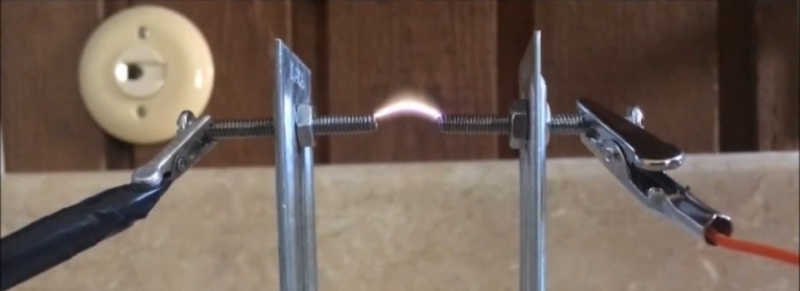

[Ashish] let us know about his experiments in recreating the earliest type of radio set: a spark-gap transmitter and iron-filings coherer. He goes through the historical development of the kit in great detail, so we’re just going to skip that part. Go read it yourself!
Instead, we’re going to tease you with the coolest part of the rig: the coherer. In [Ashish]’s build, it’s a piece of tubing with some iron filings between two bolts. When a sufficiently strong EM wave hits the filings, they stick together and bridge the gap between the bolts, allowing electricity to flow and light up an LED, for instance. You can see this in [Ashish]’s video below the break, along with kmore discussion of that coherer.
A coherer is a one-shot receiver — the filings have to be physically separated after each reception. Repeatedly tapping on the coherer by hand must have gotten old pretty quickly: period coherers included a “decoherer” — an electromechanical tapper that reset the coherer multiple times per second by hitting it, and contribute to a low buzzing sound when receiving with one.
Human ingenuity being what it is, there were many advances in coherer design over a few decades before crystals made them entirely obsolete. We love peering into these technological cul de sacs and finding that they were full of cleverness. We hope [Ashish] keeps playing around with coherers.
Most of us at Hackaday are licensed amateur radio operators, and we should definitely note that a spark-gap is a ridiculously broadband emitter, and you’re probably transmitting on all sorts of frequencies for which you don’t have a license. The fact that [Ashish]’s signal is strong enough to move iron filings across the room suggests that he might also be interfering with other people’s radio in the neighborhood, or further. A quick check with an AM radio, for instance, would be indicative.
It does look like it’s possible to get permission to run an experimental spark gap transmitter in the form of a Special Temporary Authority from the FCC, though, so all is not lost. If anyone else knows something about legally operating a spark-gap transmitter, please post up in the comments. The retro tech is cool enough that you know people are going to be trying this — let’s see if we can find a way to do so responsibly?
[Ashish] suggested to us that a coherer can probably make a pretty decent lightning detector. We know what our next quickie project is going to be.




I doubt an STA, or any other provision in the law, would allow this in the US. The STA specifies that it is a) for cases where the time needed for a regular license issue is impractical, and b) the same noninterference requirement as all other licenses
static says:By choosing his language carefully when providing a link to the information about the STA of topic Al was pretty clear such a STA isn’t going to be common occurrence. In visiting the link one would have learned that this was for one time event of limited duration using very limited power Mark says:
If this is against FCC rules, then all mechanically commutated Tesla coils are also against the rules.
rj says:Spark gap transmitters are against FCC rules because it’s an RF transmitter that transmits out-of-band, and it’s basically impossible to make it not do so.
Mark says:Yes, I understand that. Mechanically commutated Tesla coils use the the same principle to generate high frequency current pulses near the resonant frequency of the secondary coil, and because there is no way of suppressing the frequencies around the resonant frequency or harmonics thereof, the mechanically commutated Tesla coil acts as a very high power spark gap transmitter.
static says:The FCC may treat Tesla coils as incidental radiators, I wouldn’t know. I would think to operate one enough to create interference to (FCC licensed) radio services complaints the FCC would have jurisdiction and could prohibit your operating one if you can’t eliminate the interference. Something to consider before investing money and time into a Tesla Coil.
RÖB says: What! It’s not out of band. It’s band is DC to 25 GHz lol Antron Argaiv says:Well, you can put a tuned filter on the output, that will band-limit it. You can also run a spark gap without an antenna, which is what the New England Wireless and Steam Museum does with theirs. I was lucky enough to be able to try it, and it is very impressive. Blue sparks and lots of noise. Real old-timey CW, just like Marconi! http://www.newsm.org/
YO9GJX says:You do not need special license for Tesla Coils experiments and i think is not need also for Spark transmitters if you experiment with low power. The basic transmission is in VLF and low range. Using high power will be a problem.
Ken says:In the US, transmitting below the AM broadcast band (so-called VLF) falls under Part 15, defining ‘Low Power’ as about 100 mW and very limiting antenna restrictions as I understand it… >
Ken says:I’ve often read/heard comments to the effect that an automobile is effectively a spark gap generator/transmitter… Oh, and here’s this from the ARRL on Spark Gap Technology: http://www.arrl.org/files/file/History/History%20of%20QST%20Volume%201%20-%20Technology/Kennedy%20N4GG.pdf
static says:All spark ignition ICE have the potential to create incidental radiation interference, but rarely are they a widespread problem anymore.
Hyratel says:they’re also well-shielded with an electrical ground-mass of the engine block and car frame, and magnetos are shielded by the magneto structure, which is generally grounded, including in an integral mag, where the flywheel acts as the grounding shield